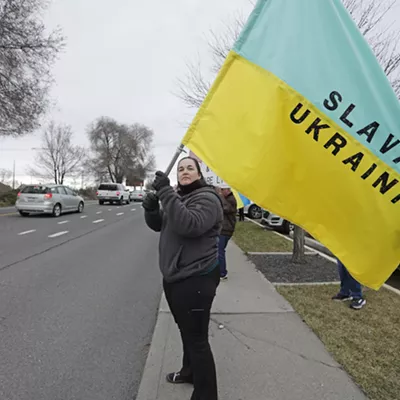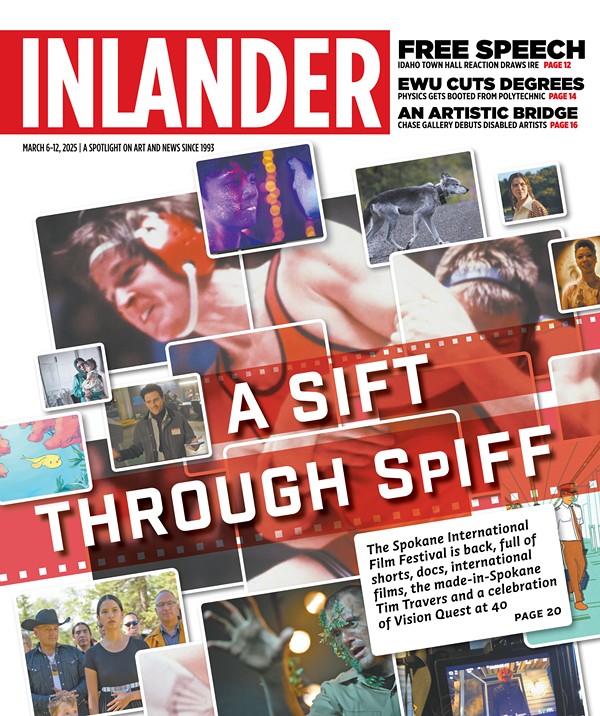Top 10 movies -- Our critics agree that Peter Jackson's epic The Return of the King is the best film of 2003, but there are plenty of others worth seeing, too.
Ed's List -- Two years ago, I had to struggle among A.I. - Artificial Intelligence, A Beautiful Mind, and The Lord of the Rings: The Fellowship of the Ring to deermine my favorite film. Last year it was between Adaptation, Far From Heaven and The Two Towers.
Does anyone see a pattern developing? If forced to pick one, then yes, my favorite movie of the year was The Lord of the Rings: The Return of the King. But it was a year that also had many other good ones.
So, with an initial long list of 23 titles, there's been some whittling down. Runners-up include: Bad Santa, The Last Samurai, Lost in Translation, 21 Grams, and X2: X-Men United.
The Top 10 are the ones that dazzled me, the ones that will most likely become members of my DVD collection. They're listed in chronological order of release dates.
Winged Migration: A mesmerizing French documentary that relied more on visuals than words. The filmmakers followed birds on their migratory routes to find food all over the world. A lot of the action was set up, so it wasn't a documentary in the purist tradition. While some of our flying friends appeared to be in grave danger, hardly any of them actually were - though the inclusion of American hunters shooting a few of the birds down was perhaps a French criticism of our violent habits.
Finding Nemo: It became the most popular animated film of all time. And in the grand Disney tradition, it focused plenty of attention on both the little kids in the audience (bright colors, funny gags) and the adults who brought them (dentist jokes, those who make dentist jokes). The film also brought state-of-the-art animation techniques to new heights and perfectly paired Albert Brooks voicing a nervous Nellie fish, and Ellen DeGeneres voicing -- at breakneck speed -- an addled goofball fish.
Pirates of the Caribbean: No one thought a film based on a Disney ride would make waves, but then along came Johnny Depp, wonderfully borrowing the laid-back swishiness of Keith Richards - then putting on plenty of eyeliner -- and the film jumpstarted into campy brilliance. Plenty of swishbuckling adventure on the high seas, a very funny cameo by a mule, and some good old-fashioned visual effects involving the titular characters, who turn into skeletons whenever they step into moonlight.
Seabiscuit: The story was true, and that just made it all the more fantastic to watch unfold. The jockey was a loser, the trainer was a lost soul, the owner couldn't get over a personal tragedy, the horse was mistreated and ignored. But when they all met, there was magic. Solid acting from everyone, even though it's weird to see close-ups of Tobey Maguire riding, with an obviously fake horse neck and head below him.
The Magdalene Sisters: It's also hard to believe that this story really happened. Through much of 20th-century Ireland, Catholic leaders sent supposedly wayward girls to church-run laundries, where they were to spend their lives doing drudge work while repenting for their "sins." They were only released if a family member came to get them, or if they became nuns, or if they died. Most of the laundries were awful places - unsanitary hotbeds of abuse. An amazing, powerful film. Writer-director Peter Mullan cameos as a horrid dad.
Mystic River: Clint Eastwood the actor is tough and squinty-eyed. Clint Eastwood the director is an artist. His version of the Dennis Lehane novel retained all of the book's moodiness. The story was of three boyhood friends, one of whom lived through a horrible event, all of whom grew up scarred by it. It's tough to figure who should get an Oscar nomination: Sean Penn's suffering father figure, Tim Robbins' shell of a man or Marcia Gay Harden's freaked-out wife.
Kill Bill: Vol. I: Too bad Quentin Tarantino doesn't do this more often. The most violent film of the year - a bride went hell-bent for revenge after her wedding party was murdered and she was left for dead - was also one of the most fun to watch, because the violence was so over the top. In Tarantino Land, when someone is decapitated, he doesn't just bleed - his blood gushes up to the ceiling. But the real highlights were the fight pieces - probably about a thousand bad guys versus heroine Uma Thurman. Guess who won. Vol. 2 is tentatively scheduled for February.
Master and Commander: The Far Side of the World: Russell Crowe made for a perfect British ship captain who had the respect of his crew and the know-how to get out of any jam. The story of his crew's pursuit of a larger ship that had attacked them was at the film's center. But there was also a great deal about the lives of sailors, about tight friendships, about music, and about nature. The saving grace came from the subtle and innovative story twists.
The Lord of the Rings: The Return of the King: The most fearsome spider in screendom, the best moment of two massive armies colliding on a battlefield ever filmed, an incredible emotional sequence involving the demise of a former Hobbit, and terrifically developed heroes and villains. This is a stunning achievement by director Peter Jackson - keeping Tolkien's vision intact while presenting his own breathtaking ideas of what the film should look and feel like. I can't wait to see it again and again.
Big Fish: There are no better spinners of light, fantastic tales than Tim Burton. What better topic, then, than a guy who spins light, fantastic tales. Though disguised as a father-son relationship story, this was more about tolerance and forgiveness. As an ensemble piece, no one really stood out here (except the giant). Each character was as important as every other one, whether dealing with real-life hassles or as part of a possibly made-up world.
Marty's List -- Curse these Top Ten lists, and the choices they force us to make. If I was asked to immediately name the year's ten best films, I would name director Sofia Coppola's Lost in Translation as my favorite, and the best all-around film.
But life never wants to work out as tidily as you'd like. And this year, for all of the advantages of Coppola's wonderful film, I'm forced to concede that at least two films are better. Or, actually, eight films are better. Because this was the year in which the final installments of two monumental cycles of films were released. From Hollywood (and New Zealand), Peter Jackson delivered The Return of the King, capping of his visit to Middle Earth in The Lord of the Rings. And from the art world, sculptor and performance artist Matthew Barney concluded his five-film Cremaster Cycle with the centerpiece film, Cremaster 3.
Comparing these two cinematic achievements makes my head hurt. One is pure movie magic, delivered with perfection and technical wizardry. The other is abstract, hypnotic, and uses film to contain a work of art that extends beyond the movie theater. Furthermore, as final releases in larger cycles of films, they beg the question whether they represent their complete cycles.
To that, I have to answer 'yes.' Neither The Cremaster Cycle nor The Lord of the Rings could have been made and released in a single year. And in the case of both cycles, when the final film was released, theaters screened all the related movies together. It's clear that Return of the King and Cremaster 3 are capstones for the larger films, and so I'm going to compare the cycles.
Lord of the Rings wins, putting Return of the King at the top of my list. Perhaps it's the epic fantasy, which is rarely done well in film. Maybe it was director Peter Jackson's deft handling of dozens of characters and situations over the course of the movies. Or maybe it was just that the special effects and action scenes were some of the most exciting things ever captured on film. Either way, when I think of Lord of the Rings, I realize that it delivers all the magic that I desire from movies, and it rarely disappoints. On its own, Return of the King is unbalanced, with an ending that goes on too long for one film. But seen as the conclusion of a nine-hour trilogy, it's a perfect film. And perhaps Jackson was responding to critics who want to insist that Return of the King is only one film in the trilogy and should be judged separately, when he has Gimli the dwarf remark "That only counts as one," during a battle in which Legolas (the dreamboat elf) single-handedly takes down a massive elephantine creature. Maybe it is only one, but it's the one.
Cremaster 3, however, as the conclusion and representative of artist Matthew Barney's epic Cremaster Cycle, takes a close second. This is certainly not traditional filmmaking. Barney's movie is slow in the extreme, explicitly sexual in ways that would make Hollywood cringe, and daringly abstract. An encyclopedia wouldn't do the film's nuances justice. In the end, this is probably too much for one film to contain. But, anyone who makes a ten-hour-long film cycle that is daringly abstract and a masterpiece at the same time deserves credit. Whether or not mainstream filmmakers want to take any clues from Barney, he's stretched the medium of film as much as Jackson has confirmed its power during the past year.
That brings us to No. 3: Sofia Coppola's marvelous Lost in Translation, which is the movie I most enjoyed rewatching this year. Her simple film tells the story of an aging actor (Bill Murray), who comes to Tokyo to film a whiskey commercial for an embarrassing amount of money. Bored and reflective, he finds his quest mirrored in a young woman co-habiting his hotel (Scarlett Johanssen). Murray is both hilarious and poignantly sad, as any good clown should be, and deserves every acting accolade we can throw at him. And Johanssen emerges as one of the best leading actresses in ages. And she happens to do it in the Casablanca of the 21st century.
Spellbound is a documentary about the national spelling bee. For a true-life film about such a simple subject, it's a delight to observe how much tension, drama, and character director Jeffrey Blitz finds. The fact that it plays like a well-made melodrama is further proof that, when it comes to documentaries, the work of the editor is at least as important as the subject. This could have been boring; instead, it's a roller coaster ride of a movie without any action.
An entirely different approach to a real subject was taken by Shari Springer Berman and Robert Pulcini, co-directors of American Splendor. They wanted to tell the life story of comic book writer Harvey Pekar and his wife. So they enlisted both actors to portray the couple and the actual couple themselves, to comment on themselves as portrayed in the movie. For that setup alone, the movie wins the "weird" award, even with Cremaster as competition. But the technique is more than just show. In the end Pekar and his wife reveal much of themselves and tell us a little about art as well, thanks to the film's cleverness.
I liked all the remaining films on my list. But they're a mixed bag, and each one has a weakness. Perhaps this was a bad year for film (the box office certainly hasn't had a good year - there was no growth for the first time in more than a decade). But a few flickers of hope emerged. In no particular order, I'll end my list with Casa de los babys, Finding Nemo, Fog of War, X2: X-Men Unite, and Cabin Fever. A few of them are politically savvy (in Fog of War Errol Morris interviews Robert McNamara, and in Casa, John Sayles looks at adoption). The others are smart and slick. They were all worth the full price of admission. But they could have been better. Let's hope that in 2004, filmmakers learn from directors like Jackson and Coppola, or that they take the risks of Cremaster and American Splendor to heart.
Director John Sayles (Lone Star) has long been considered a maverick of American cinema, but I've always found his films to be lacking in velocity. Fortunately, with Casa de los babys, he's crafted a film that, in fleeting glimpses, takes us into the lives of a hotel full of American women who have traveled to South America to await babies for adoption. The cast of actresses are given vignettes in which to shine, and Maggie Gyllenhaal, Daryl Hannah and Rita Moreno all reveal heartbreaking talents.
Finding Nemo, the computer-generated undersea (for the most part) adventure is pure cuddly goodness. You can love it for the goofy cast of characters (a laid-back sea turtle is my personal favorite), or the great voice acting. Either way, the film is a family movie, made with class, that manages to be as smart as it is sweet.
Can you stare down Robert McNamara, the U.S. Secretary of Defense during the Vietnam War? In Fog of War, you have the chance to do just that. Errol Morris, the documentarian who made Mr. Death, shows us a towering figure whose very human strengths and weaknesses shaped the direction of the world. And we watch as he evaluates himself. It's chilling and heartbreaking.
X-2: X-Men United was a surprise. Sure it's a big-budget, Hollywood-slick production. But it's also a subversive, funny film that delivers a broad-reaching exploration of tolerance to a multiplex audience. It's a rare filmmaker and cast that can succeed at that sort of juggling act, so it's good to know that we can expect more from that X-Men in future films.
Finally, I have to admit that I'm a sucker for good horror. Whether it's silly (like Freddy vs. Jason was) or sick (Texas Chainsaw Massacre), I'll usually have a good time. But Cabin Fever was a genuine surprise. It's a throwback to an older style of horror film in which the terror comes from within and our bodies are shown at their most vulnerable. The whole thing is funny and creepy at the same time.
Publication date: 1/08/04
















